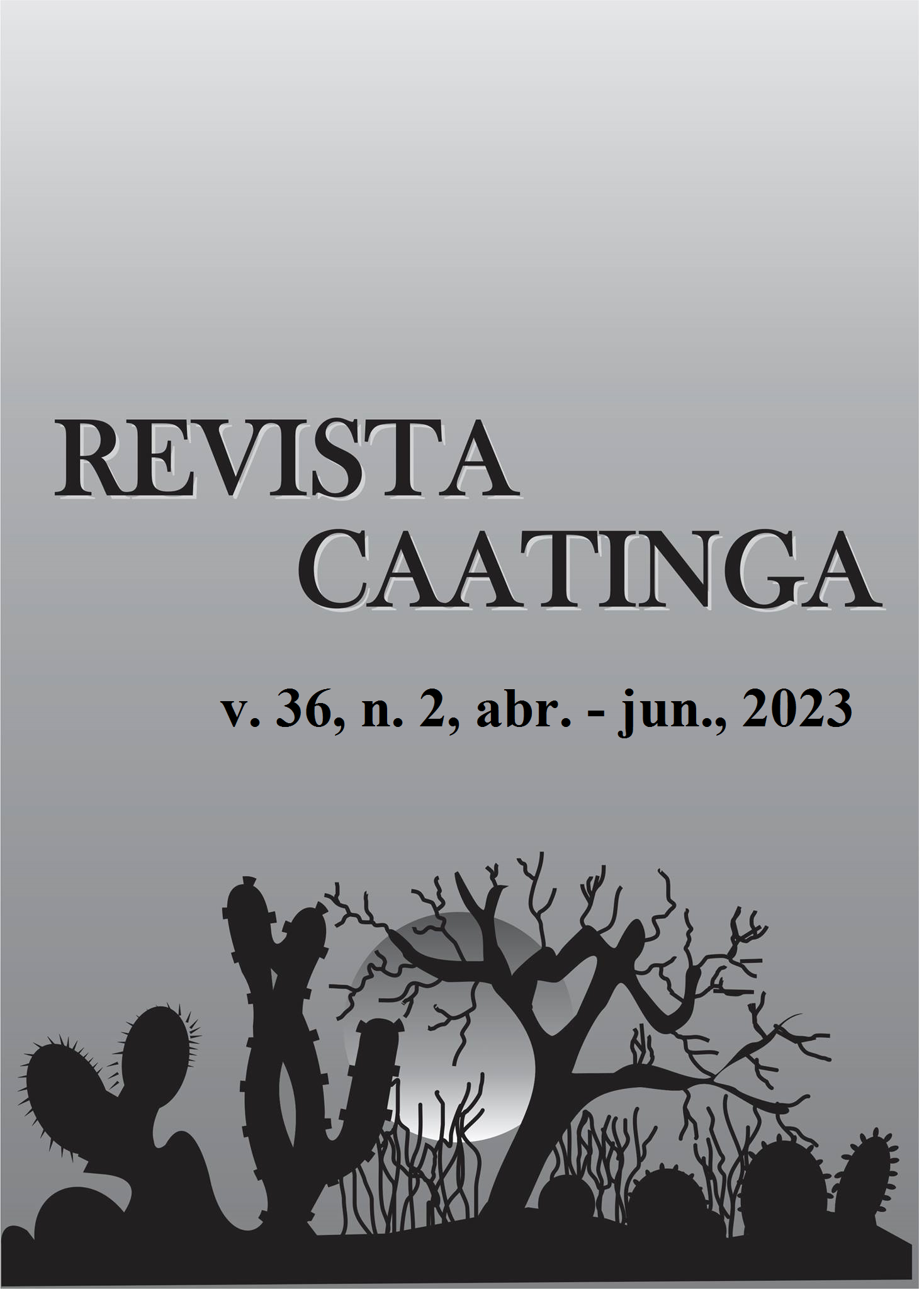Genetic parameters in melon sub-accessions from traditional agriculture
DOI:
https://doi.org/10.1590/1983-21252023v36n209rcKeywords:
Cucumis melo. Diversity. Heritability. Genetic gain.Abstract
Family farming in Brazil holds a high diversity of melon germplasm, composing an important source of alleles for breeding programs. Thus, the objective of this study was to estimate genetic parameters and select genotypes from a population of melon sub-accessions from different botanical varieties grown by family farmers, based on morphological parameters. Two experiments were conducted, one in 2019 and another in 2020, in a complete randomized block design, with three replications and five plants per plot, using 27 melon sub-accessions (generation S2) from family farmers, and a commercial variety. Nine quantitative descriptors were evaluated. Assumptions of ANOVA were tested, followed by individual and joint analyses of variance. Significant differences were found among sub-accessions for all descriptors evaluated, with heritabilities higher than 83% and significant genotype-environment interactions for 88.8% of the characteristics evaluated. Thus, genetic variability was found among sub-accessions, with predominance of genetic effects over environmental effects, denoting the possibility to obtain genetic gains by the improvement of several characteristics of agronomic interest. The sub-accessions BGMEL66.0, BGMEL111.0, and BGMEL112.0 are recommended for inclusion in breeding programs focused on obtaining good prolificacy and small fruits with high soluble solid contents. BGMEL sub-accessions (108.3 and 108.5) can generate progenies with high prolificacy, and sub-accessions of the variety momordica can be used for generation of progenies focused on shortening the crop cycle and increasing fruit size.
Downloads
References
AGRITEMPO. Sistema de monitoramento agrometeorológico. Disponível em: <http://www.agritempo.gov.br/agritempo/jsp/Estatisticas/index.jsp?siglaUF=BA>. Acesso em: 23 fev. 2021.
AMORIM, C. C. et al. Morphological diversity and identification of accessions of melon. African Journal of Agricultural Research, 11: 3622-3632, 2016.
ANDRADE, C. A. et al. Morphoagronomic genetic diversity of Brazilian melon accessions based on fruit traits. Scientia Horticulturae, 243: 514-523, 2019.
ARAGÃO, F. A. S. et al. Genetic divergence among accessions of melon from traditional agriculture of the Brazilian Northeast. Genetics and Molecular Research, 12: 6356-6371, 2013.
ARAGÃO, F. A. S.; NUNES, G. H. S.; QUEIRÓZ, M. A. Genotype x environment interaction of melon families based on fruit quality traits. Crop Breeding and Applied Biotechnology, 15: 79-86, 2015.
BORÉM, A.; MIRANDA, G.V.; FRITSCHE-NETO, R. Melhoramento de plantas. 7ª. ed. Viçosa, MG: UFV, 2017. 543p.
CRUZ, C. D.; REGAZI, A. J.; CARNEIRO, P. C. S. Modelos biométricos Aplicados ao Melhoramento Genético. 4. ed. Viçosa, MG: UFV, 2012. 514 p.
CRUZ, C. D. Genes: a software package for analysis in experimental statistics and quantitative genetics. Acta Scientiarum. Agronomy, 35: 271-276, 2013.
CRUZ, C. D.; CARNEIRO, P. C. S; REGAZI, A. J. Modelos biométricos Aplicados ao Melhoramento Genético. 3 ed. Viçosa, MG: UFV, 2014. 668 p.
DANTAS, A. C. et al. Caracterização molecular de acessos de melão coletados no Nordeste brasileiro. Revista Brasileira de Fruticultura, 34, 183-189, 2012.
FERREIRA, M. G. et al. Parâmetros genéticos, dissimilaridade e desempenho per se em acessos de abóbora. Horticultura Brasileira, 34: 537-546, 2016.
IBGE - Instituto Brasileiro de Geografia e Estatística. 2020. Produção agrícola municipal. Disponível em: <https://sidra.ibge.gov.br/tabela/1612>. Acesso em: 25 jul. 2022.
IPGRI – International Plant Genetic Resources Institute. Descriptors for melon (Cucumis melo L.). Rome: International Plant Genetic Resources Institute, 2003. 65 p.
MACÊDO, S. S. et al. Botanical identification and genetic diversity in melons from family farming in the state of Maranhão. Revista Caatinga, 30: 602-613, 2017.
PITRAT, M.; HANELT. P.; HAMMER, K. Some comments on interspecific classification of cultivars of melon. Acta Horticulturae, 510: 29-36, 2000.
PITRAT, M. Phenotypic diversity in wild and cultivated melons (Cucumis melo). Plant Biotechnology, 30: 273-278, 2013.
QUEIRÓZ, M. A.; BARBIERI, R. L.; SILVA, R. A. M. Ocorrência de variabilidade genética em plantas exóticas no Brasil. In: VEIGA, R. F. A.; QUEIRÓZ, M. A. (Eds.). Recursos Fitogenéticos: A base da agricultura sustentável no Brasil. 1 ed. Brasília, DF: Sociedade Brasileira de Recursos Genéticos, 2015. cap. 11, p. 135-147.
TRIMECH, R. et al. Genetic variation in Tunisian melon (Cucumismelo L.) germplasm as assessed by morphological traits. Genetic Resources and Crop Evolution, 60: 1621-1628, 2013.
VALADARES, R. N. et al. Estimativas de parâmetros genéticos e correlações em acessos de melão do grupo momordica. Horticultura Brasileira, 35: 557-563, 2017.
YILDIZ, M.; AKGUL, N.; SENSOY, S. Morphological and Molecular Characterization of Turkish Landraces of Cucumis melo L. Notulae Botanicae Horti Agrobotanici, 42: 51-58, 2014.
Downloads
Published
Issue
Section
License
Os Autores que publicam na Revista Caatinga concordam com os seguintes termos:
a) Os Autores mantêm os direitos autorais e concedem à revista o direito de primeira publicação, com o trabalho simultaneamente licenciado sob a Licença Creative Commons do tipo atribuição CC-BY, para todo o conteúdo do periódico, exceto onde estiver identificado, que permite o compartilhamento do trabalho com reconhecimento da autoria e publicação inicial nesta revista, sem fins comerciais.
b) Os Autores têm autorização para distribuição não-exclusiva da versão do trabalho publicada nesta revista (ex.: publicar em repositório institucional ou como capítulo de livro), com reconhecimento de autoria e publicação inicial nesta revista.
c) Os Autores têm permissão e são estimulados a publicar e distribuir seu trabalho online (ex.: em repositórios institucionais ou na sua página pessoal) a qualquer ponto antes ou durante o processo editorial, já que isso pode gerar alterações produtivas, bem como aumentar o impacto e a citação do trabalho publicado (Veja O Efeito do Acesso Livre).







